MicroWave_Sensor_SKU__SEN0192 - jimaobian/DFRobotWiki GitHub Wiki
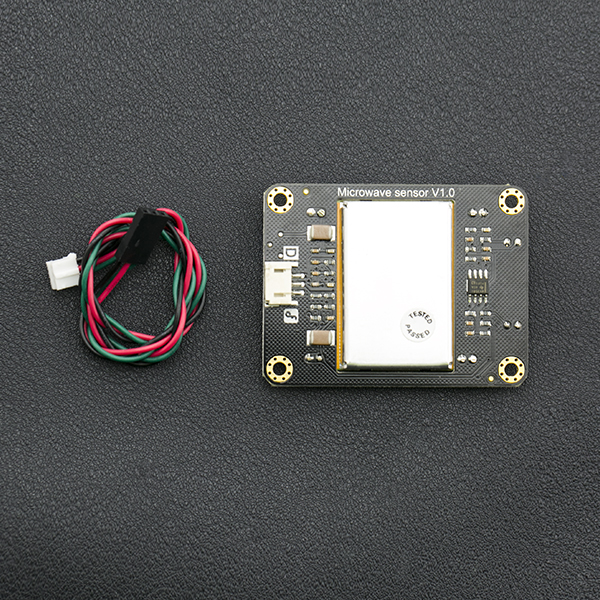
The microwave sensor uses doppler radar to detect moving objects using microwaves. This differs from the method used by a regular infrared (IR) sensor as the microwave is sensitive to a variety of objects that can reflect microwaves, and its sensor readings are not affected by the ambient temperature. This type of sensor is widely used in industrial, transportation and civil applications such as measuring a vehicle's speed, measuring liquid levels, automatic door motion detection, automatic washing, production line material detection, car reversing sensors, etc. The microwave detection method has the following advantages compared with other detection methods:
- Able to detect objects without physical contact
- Readings not affected by temperature, humidity, noise, air, dust or light - suitable for harsh environments
- Strong resistance to radio frequency interference
- Low output, not harmful to the human body
- Microwaves have a wide detection range and velocity equal to the speed of light
- Supports non-life-class object detection Specification
- Working Voltage: 5V + 0.25V
- Working Current(CW): 60mA max., 37mA typical
- Size: 48.5x63mm
- Emission: * Detection Distance: 2-16M continuously adjustable * Emission Frequency: 10.525 GHz * Precision Frequency Setting: 3MHz * Output Power (Minimum): 13dBm EIRP * Harmonic Emission: < -10dBm * Average Current (5%DC): 2mA typ. * Pulse Width (Min.): 5uSec * Load Cycle (Min.): 1%
- Reception: * Sensitivity (10dB S/N ratio) 3Hz to 80Hz bandwidth: -86dBm *3Hz to 80Hz Bandwidth Clutter: 10uV * Antenna Gain: 8dBi * Vertical 3dB Beam Width: 36 degrees * Level 3dB Beam Width: 72 degrees

The following diagram demonstrates the working principle of the sensor module. It works by amplifying a tiny signal which is received by the microwave sensor, and then through the comparison circuit it converts the signal into a square signal with a digital output of 0 or 1 which an Arduino or other micro controller can easily handle.
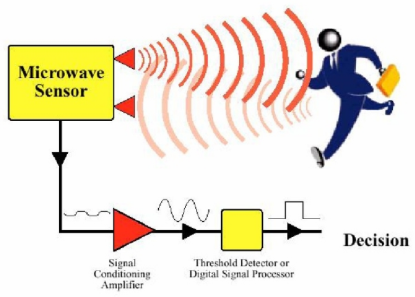
Detection Angle: The angle of detection is 72 degrees with the antenna in a parallel direction (azimuth) The vertical (pitch) direction of the antenna is 36 degrees.
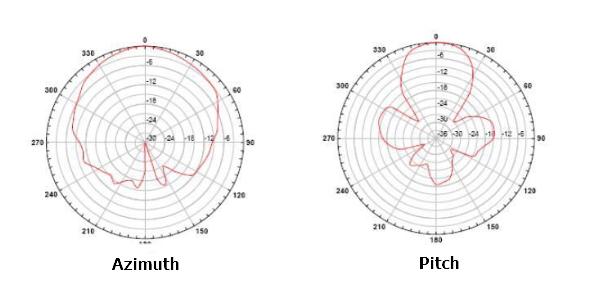
Microwaves can penetrate through walls. So sometimes it is inaccuracies when microwaves penetrate to outside walls and detect moving objects in non-target areas. Be sure to choose an installation location to avoid this!
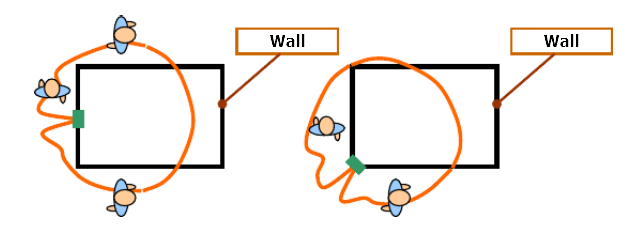
When the microwave sensor does not detect moving objects, the indicator LED remains off. When the sensor detects moving objects, the LED will turn on and the output level will be change from HIGH to LOW. The LED will automatically turn off about after 0.5s and the output level will change from LOW to HIGH. If the microwave sensor detects continuously moving objects the LED will keep flashing on and off. The output level will fluctuate between HIGH and LOW until the object stops moving.
The microwave sensor has a distance range of 2-16m. The detection distance can be adjusted using the potentiometer. If it is turned in the direction on MIN, the detection distance decreases. If it is turned in the opposite direction, the range increases.
| ''' ''' | Microwave Sensor | IR Sensor |
| Trigger Mode | Movement | Infrared Reflection |
| Temperature Influence | No Influence | Over 40 degrees C can inhibit function |
| Object Penetration | Able to penetrate any non-metallic object | Unable to penetrate |
| Ambient Environmental Requirements | No requirements | Dusty or brightly lit environments can inhibit function |
| Working Life | more than 100,000 hours | about 1000 hours |
| Stability | Very reliable and stable | Induction distance will shorten over time |
| #### Requirements |
-
Hardware
- Arduino UNO (or similar) x1
- Microwave sensor x1
- 3PIN digital cable x1
-
Software
- Arduino IDE V1.6.5 Click to Download Arduino IDE from Arduino®
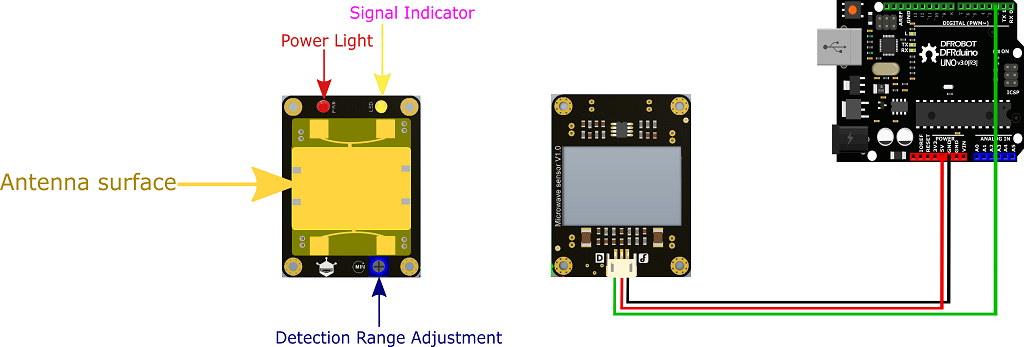
 Align the antenna surface towards the area you need to detect
Align the antenna surface towards the area you need to detect
 Note: The sensor can be adjusted continuously within the range of 2-16m. Turn the potentiometer in the direction of MIN and the detection range decreases. Turn the potentiometer in the opposite direction and the detection range increases.
Note: The sensor can be adjusted continuously within the range of 2-16m. Turn the potentiometer in the direction of MIN and the detection range decreases. Turn the potentiometer in the opposite direction and the detection range increases.
Please download MsTimer2 library first. Here is tutorial about Library installation.
#include <MsTimer2.h> //Timer interrupt function library
int pbIn = 0; // Define interrupt 0 that is digital pin 2
int ledOut = 13; // Define the indicator LED pin digital pin 13
int number=0; //Interrupt times
volatile int state = LOW; // Defines the indicator LED state, the default is not bright
void setup()
{
Serial.begin(9600);
pinMode(ledOut, OUTPUT);//
attachInterrupt(pbIn, stateChange, FALLING); // Set the interrupt function, interrupt pin is digital pin D2, interrupt service function is stateChange (), when the D2 power change from high to low , the trigger interrupt.
MsTimer2::set(1000, Handle); // Set the timer interrupt function, running once Handle() function per 1000ms
MsTimer2::start();//Start timer interrupt function
}
void loop()
{
Serial.println(number); // Printing the number of times of interruption, which is convenient for debugging.
delay(1);
if(state == HIGH) //When a moving object is detected, the ledout is automatically closed after the light 2S, the next trigger can be carried out, and No need to reset. Convenient debugging.
{
delay(2000);
state = LOW;
digitalWrite(ledOut, state); //turn off led
}
}
void stateChange() //Interrupt service function
{
number++; //Interrupted once, the number +1
}
void Handle() //Timer service function
{
if(number>1) //If in the set of the interrupt time the number more than 1 times, then means have detect moving objects,This value can be adjusted according to the actual situation, which is equivalent to adjust the threshold of detection speed of moving objects.
{
state = HIGH;
digitalWrite(ledOut, state); //light led
number=0; //Cleare the number, so that it does not affect the next trigger
}
else
number=0; //If in the setting of the interrupt time, the number of the interrupt is not reached the threshold value, it is not detected the moving objects, Cleare the number.
}There are no questions about this product yet. If you have any problems or suggestions, you are welcome to email us or post on the DFRobot forum!
 For any questions/advice/cool ideas to share, please visit the DFRobot Forum
For any questions/advice/cool ideas to share, please visit the DFRobot Forum
 get it from dfrobot store or dfrobot distributor.
get it from dfrobot store or dfrobot distributor.